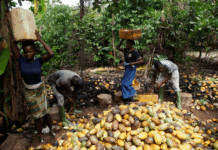Farming, though not an attractive employment opportunity for many young individuals in the country, it is a blessing in disguise. Farming as a business is lucrative and at the same time very unattractive when approached with a cultural attitude.
Undoubtedly, we have few of the youths involved in farming. As recorded in The Ghana Census of Agriculture (GCA), 2017/18, only 29.7% of people engaged in agriculture are youths (15-35 years).
Despite a small percentage of youth involved in farming, there’s hope for those engaged.
Since agriculture remains the backbone of Ghana’s economy, every other government initiate policies and programs basically to develop the sector.
In April 2017, the president of Ghana H.E Nana Addo Dankwa Akufo-Addo initiated a flagship agriculture program called Planting for Food and Jobs (PFJ). PFJ under the watch of Dr. Owusu Afriyie Akoto; the minister for Food and Agriculture is aimed at developing Ghana’s agriculture sector to create jobs and to move the country into a food secure state. Since its inception, the program has received a lot of attention from the media and has led in all agriculture discourse. The five years-long programs have other sister programs like the Rearing for Food and Jobs (RFJ) and Planting for Export and Rural Development (PERD). Working with farmers in diverse rural communities, here, I stand to share some of the impact and opportunities created by the program as well as the lapses and the way forward.
Land Accessibility.
The country’s agricultural lands are underutilized because the means of production are hard to come by especially among the youth. However, one beautiful culture that exists in most rural communities is how they are willing to offer their lands to the youths for farming. In some communities, what one needs to do is to get one or two of these items; Kola, Schnapps, Skin of a Sheep, Palm wine, Pito (a local drink made from fermented corn), and One Hundred Ghana Cedis. With these requirements, a Chief can allocate as much as ten acres of land to one to farm arable crops.
The elders of these communities believe that, if even the dead keep increasing their numbers, how much more they the living. PFJ has even made most communities very open to youth farmers today. Some community Chiefs now advocate for youth involvement in the program since they are willing to give them lands to farm. Having access to land becomes much easier when a youth enters a community through the assistance of the various District Agriculture Departments.
Land Preparation.
Since the commencement of the program, a huge number of farmers have benefited immensely from this life-transforming policy. Though there is no land preparation package attached to the policy, steps have taken to revamp the country’s agriculture mechanization services unit. For some districts and constituencies, the assembly or the Members of Parliament have provided tractors to support this initiative in their respective areas. These tractors plow between 40% to 50% discount of the original charge. This has equally reduced the cost of production by a significant margin.
Fertilizers.
Soil nutrient depletion has been so drastic in our time. Hence, crop nutrient requirements in many cases must be supplemented from an organic or inorganic source. For ideal yields, maize must be supported with N.P.K at the growing stage and Urea at the tasseling stage. On averagely performing soils, farmers use 150kg of N.P.K and 50Kg of Urea per acre. The provision of subsidized fertilizer is a major pillar of the PFJ program. Aside from the unprecedented slashing of fertilizer prices by 50% subsidy, availability has also improved. The government now outsources from local producers.
These new N.P.K (+ TE) are with trace nutrients for better growth and yield of crops. Previously, imported N.P.K weren’t fortified with these trace nutrients. In the open market, 50Kg of N.P.K used to be sold between Ghc.150 to Ghc. 180 but the same quantity goes for Ghc. 80 under PFJ. Urea is equally Ghc. 80 under PFJ even though it is -sold between Ghc. 120 and Ghc. 160 in the open market. One significant change resulting from PFJ is a positive toll on the prices of fertilizers in the open market. While the prices of fertilizers have to fall, there’s equally a break from the overwhelming annual rise in the prices of fertilizers. This increased the number of farmers who access and used fertilizers to improve their yields.
Seeds.
Improved seeds are an indispensable resource for agriculture development and growth. Since the initiation of PFJ, improved seed from both local and foreign sources have been made available to farmers. Top-notch corn seeds like Pannar, Lake, and Pioneer which were expensive for farmers are now sold at 50% of their original prices. Just like fertilizer, these improved seeds are available in the system. The advantage in planting these varieties under PFJ is that they give a high yield and they are more resistant to drought as compare to the traditional seeds our farmers plant.
Pests.
Recently, the biggest enemy to maize farmers in Ghana is the Fall Army Worm (F.A.W). The devastating nature of the worm with an uncontrolled appetite for the corn at all stages of growth is very worrying. A number of proactive measures have been considered to combat the worm under PFJ to subdue the ripen effect of the worm on the corn. Educating farmers about the worm have been supported with the distribution of chemicals to spray the worms. The good news is that these chemicals since 2017 are freely given to the farmers at no cost through the various District Agriculture Departments. This has been a worthy relief to farmers. This has also given birth to innovative ways of using local herbs to control the worm.
Yield Improvement.
There has been a meaningful improvement in the yields of corn for the past years. Farmers who planted hybrid varieties and apply the right amount of fertilizers on a timely basis have recorded an impressive improvement in their yields per acre. Currently, under optimum environmental conditions with the right agronomic practices, a farmer can harvest between 1.25 tons and 2 tons on an acre.
Storage and Marketing.
Smallholder farmers continually struggle with the poor handling of their harvest. Storage is the next step after harvest when foods aren’t moved immediately to the market. While the country put up a warehouse closer to the farmers, new hope sparks in the heart of the farmers. The disruptive nature of our rural-urban market network in many instances compels farmers to sell at relatively low prices. Now farmers have the free will to sell their harvest to the National Buffer Stock. Farmers are mostly aware of the pricing of the National Buffer Stock which isn’t influenced by availability during harvesting season. In the open market, farmers are most likely to face poor pricing at the peak harvest period.
Apparently, there is an advantage in selling to National Buffer Stock since their prices are predetermined at the beginning of the season. This has increased the marginal profits of farmers since the effect of demand and supply on pricing is neutralized by this system. In addition, it has helped the marketing power of farmers and reduced the stress they go through to store and to sell.
Inadequate Mechanization Services.
Surprisingly, some smallholder farmers at this age still practice the traditional methods of farming. Aside from availability problems, the cost of mechanization services is sometimes overwhelming for our poor farmers. Tractor services made available by some District Assemblies or MPs at affordable prices is being helpful. However, some farmers have the notion that the service is political, therefore, they do not want to patronize it.
Addressing this challenge will require the establishment of district-level agriculture mechanization centers. These centers should be well resourced to provide diverse mechanization services for farmers. This could be ‘Private-Government’ owned and managed to avoid the previous experience of mismanaged Agric station resources.
Unscrupulous retailing prices of seeds and fertilizers.
Annually, the Ministry of Food and Agriculture (MOFA) announces the prices of seeds and fertilizers under PFJ at the onset of the season. Irrespective of the awareness created, some unscrupulous retailers still sell these inputs more than the stipulated prices. Many hide behind transportation and milk our poor farmers. Already, great steps have been taken for branding fertilizers and seeds for PFJ. Further arrangements should be made for the branding of imported hybrid seeds for easy identification. The supply of these inputs should have a lot of checks to ensure that farmers receive them at the right price.
Merchandising Government Free Chemicals.
The alleged corruption at some of the District Agriculture Departments is demoralizing. Allegedly, some of the officers extort money from the farmers before delivering free chemicals from the government to fight the armyworm. Although some of the farmers see it as a token of appreciation, others also question the free nature of the government.
The Waiting Period.
The state of our rural economies always puts farmers in need of emergency funds. Hence, the system where buffer stock buys and pay later is not favorable for many farmers. The National Buffer Stock should be well resourced to be in the position to buy with cash in hands. This would serve as a motivation, increase patronage, and boost their confidence level for high production.
Selective Chemical Package.
Across the length and breadth of Ghana, weeds control in corn farms is a staid headache for many farmers. This significantly affects their yields since weeds compete with crops for space, nutrients, and sunlight. Aside from educating and skilling farmers on weed control, the provision of selective herbicide can help. A greater number of farmers use a few bottles to cover wider areas than they should, due to the cost involved. A little subsidy on these herbicides can help farmers purchase enough and support local producing companies.
On the side of the country where hunger and unemployment are predominant among the youth, the Planting for Food and Jobs policy should be harnessed to achieve the realization of its objectives to curtail the menace. The policy seems to have a positive effect on the farmers and the stakeholders who are both actively and passively involved, therefore, effort should be put in place to sustain the policy to continue to impact and transform the livelihoods of our farmers. Once we can maintain and develop it, farming would inevitably be enticing for the teeming unemployed youths in the country.
Written by: Samuel Abroquah








